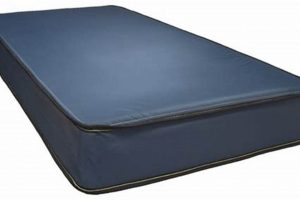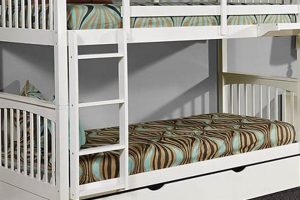A sleeping surface designed for a single occupant, often a child or adolescent, undergoes rigorous testing to achieve a specific certification. This certification indicates the product meets stringent chemical emissions standards, contributing to improved indoor air quality. Such mattresses are commonly used in homes and institutions seeking healthier environments.
The significance of this certification lies in its focus on reducing exposure to volatile organic compounds (VOCs). These compounds, released from various materials, can negatively impact health, particularly for vulnerable populations. The certification process assures consumers that the product has been independently tested and verified to emit low levels of these chemicals, promoting safer sleep and a healthier living space. This commitment to safety and well-being has gained importance as awareness of indoor air quality’s impact on health has increased.
The subsequent sections will delve into the specific standards associated with this certification, the materials typically used in these mattresses, and practical considerations for selecting the right product for individual needs.
Selection and Maintenance Guidance
The following guidelines offer insight into choosing and caring for a sleeping surface designed for a single occupant, verified to meet stringent chemical emissions standards.
Tip 1: Prioritize Certification Verification. Scrutinize product listings and labels to confirm the presence of a valid certification mark from a recognized third-party organization. Cross-reference certification claims with the certifier’s public database to ensure authenticity.
Tip 2: Assess Material Composition. Inquire about the materials used in the mattress core and cover. Opt for components known for low off-gassing potential, such as natural latex, organic cotton, or plant-based foams. Avoid products containing polyurethane foam without demonstrated emission controls.
Tip 3: Consider Breathability. Select a mattress construction that promotes airflow. Adequate ventilation reduces moisture build-up, inhibiting mold growth and further minimizing potential off-gassing.
Tip 4: Evaluate Firmness Appropriateness. Firmness should align with the sleeper’s age, weight, and preferred sleep position. A mattress that is too soft or too firm can compromise spinal alignment and sleep quality.
Tip 5: Employ Protective Measures. Use a mattress protector made from breathable, non-toxic materials to shield the mattress from spills and stains. This prolongs its lifespan and reduces the need for frequent cleaning.
Tip 6: Maintain Proper Ventilation. Regularly air out the mattress by removing bedding and opening windows in the bedroom. This facilitates the dissipation of any residual odors or trapped moisture.
Tip 7: Adhere to Cleaning Protocols. Follow the manufacturer’s recommended cleaning instructions. Avoid harsh chemicals or excessive moisture, which can damage the mattress and contribute to chemical emissions.
By adhering to these guidelines, one can select and maintain a sleeping surface that prioritizes both comfort and indoor air quality.
The next section will discuss the disposal options and environmental considerations related to mattresses certified for low chemical emissions.
1. Verified Emissions
Verified emissions form a critical aspect of understanding the value proposition of a sleeping surface designed for a single occupant that meets stringent environmental standards. This verification process ensures that the product has undergone rigorous testing to confirm its compliance with established emission limits.
- Third-Party Certification
Independent organizations, such as UL Environment, conduct testing and certification. These entities assess the chemical emissions of mattresses, specifically focusing on volatile organic compounds (VOCs). Certification ensures that the product meets predetermined thresholds, offering consumers assurance of its low-emission characteristics.
- Focus on Volatile Organic Compounds (VOCs)
VOCs are chemicals that can off-gas from various materials, including those used in mattress construction. Prolonged exposure to high levels of VOCs can negatively impact health. Certification processes target specific VOCs known to pose potential risks, ensuring that their emission levels remain within acceptable limits.
- Impact on Indoor Air Quality
The primary benefit of verified low emissions lies in their contribution to improved indoor air quality. Reduced VOC emissions translate to a healthier sleep environment, particularly for individuals sensitive to chemical exposures or those with respiratory conditions. This is particularly relevant in enclosed spaces like bedrooms.
- Transparency and Accountability
The verification process fosters transparency by providing consumers with access to information regarding a mattress’s emission performance. Certifications often include publicly available databases or directories that allow consumers to verify the validity of the claim and access detailed testing results.
The comprehensive focus on verified emissions allows consumers to make informed decisions. By prioritizing products with confirmed low-emission profiles, they actively contribute to creating healthier indoor environments, particularly in the context of sleeping surfaces designed for single occupants.
2. Child Safety
The consideration of child safety is paramount when evaluating a sleeping surface intended for young individuals. Mattresses bearing a specific low-emission certification offer a tangible avenue for mitigating potential health risks associated with indoor air quality. These risks are often amplified in children due to their developing physiology and heightened sensitivity to environmental factors.
- Reduced Chemical Exposure
Children are particularly vulnerable to the adverse effects of volatile organic compounds (VOCs) released from various materials. A low-emission certified mattress minimizes this exposure, decreasing the risk of respiratory irritation, allergic reactions, and other health concerns associated with prolonged VOC inhalation. This reduction directly contributes to a healthier sleep environment.
- Flame Retardant Compliance
Regulations mandate that mattresses possess fire-retardant properties. Mattresses often achieve this standard through the use of chemical treatments. However, some fire retardants can pose health risks. Specific certifications prioritize alternatives to potentially harmful chemicals, ensuring that the mattress meets safety requirements without compromising child well-being. Examples of safer alternatives include silica-based or
wool-based fire barriers. - Hypoallergenic Properties
Children are prone to allergies and sensitivities. Certain mattresses incorporate hypoallergenic materials, such as organic cotton or natural latex, to minimize the risk of allergic reactions. These materials are less likely to harbor dust mites or other allergens, contributing to a cleaner and healthier sleep surface.
- Firmness and Support
Appropriate firmness and support are crucial for a child’s developing spine. A mattress that is too soft can lead to improper spinal alignment, while one that is too firm can cause discomfort. Mattresses designed for children often undergo testing to ensure they provide adequate support and promote healthy posture during sleep.
The convergence of reduced chemical exposure, responsible flame retardant measures, hypoallergenic properties, and appropriate firmness underscores the significance of a focus on child safety. By prioritizing these elements, consumers can make informed decisions, fostering a healthier sleep for children.
3. Certifier Reputation
The credibility of a low-emission certification hinges directly on the reputation of the certifying body. In the context of a sleeping surface designed for single occupant that meets chemical emissions standards, the value of the certification is inherently tied to the certifier’s rigor, independence, and transparency. A reputable certifier employs stringent testing protocols, ensuring that the product genuinely meets the stated emissions criteria. Conversely, a certifier with a questionable history or lax standards undermines the consumer’s confidence and renders the certification largely meaningless. For example, a mattress bearing a certification from an organization known for conflicts of interest would reasonably raise concerns about the accuracy and validity of its low-emission claims.
The selection of a reputable certifier involves several key factors. These include the certifier’s history of unbiased assessments, accreditation by recognized industry authorities, and the availability of publicly accessible data on testing methodologies and results. Certifiers with a proven track record of upholding stringent standards inspire greater trust among consumers and manufacturers alike. The presence of robust verification processes, including independent audits and ongoing monitoring, further bolsters the certifier’s credibility. The absence of such safeguards can lead to inconsistencies and potentially misleading claims.
Ultimately, the reputation of the certifying body serves as a proxy for the quality and reliability of a low-emission designation. Consumers should exercise due diligence in researching the certifier before placing complete faith in the certification label. This assessment contributes to making an informed purchasing decision, maximizing assurance of indoor air quality benefits and overall product safety for sleeping surfaces designed for single occupancy.
4. Material Composition
The achievement of a low-emission certification is inextricably linked to the constituent materials used in the construction of a sleeping surface designed for a single occupant. Material selection directly influences the quantity and type of volatile organic compounds (VOCs) released into the indoor environment. Traditional mattress components, such as polyurethane foam and synthetic adhesives, are known sources of VOCs, including formaldehyde, benzene, and toluene. The substitution of these materials with alternatives characterized by lower emission profiles is fundamental to attaining the certification. For example, replacing conventional foam with natural latex or plant-based foams significantly reduces the potential for off-gassing. Similarly, the use of water-based adhesives or solvent-free bonding techniques minimizes the introduction of harmful chemicals into the product. Thus, the low-emission certification serves as an indicator of a deliberate choice to utilize materials that inherently contribute to improved indoor air quality.
The impact of material composition extends beyond VOC emissions to encompass other critical aspects of mattress performance. The breathability, durability, and comfort of the sleeping surface are all directly affected by the materials employed. Organic cotton, for instance, offers enhanced breathability compared to synthetic fabrics, facilitating airflow and reducing moisture accumulation. Natural latex provides superior resilience and support compared to conventional foam, contributing to improved sleep posture and long-term durability. However, it is important to note that even materials perceived as “natural” can undergo processing that introduces chemical additives. Therefore, scrutiny of the entire supply chain and manufacturing process is essential to ensure that the final product truly aligns with the low-emission designation. Reputable certifications often require transparency regarding material sourcing and manufacturing practices, allowing consumers to make informed choices based on a comprehensive understanding of the product’s composition.
In conclusion, the attainment of a low-emission certification is not merely a superficial label but rather a reflection of a fundamental commitment to material integrity. By prioritizing materials with inherently low-emission characteristics and rigorously controlling manufacturing processes, manufacturers can produce sleeping surfaces that minimize the potential for indoor air pollution and promote healthier sleep environments. Consumers seeking products that contribute to improved indoor air quality should therefore prioritize mattresses with credible certifications and thoroughly investigate the materials used in their construction. While challenges remain in terms of material sourcing and cost considerations, the increasing availability of certified products reflects a growing awareness of the importance of material composition in achieving low-emission goals.
5. Size Appropriateness
The successful integration of a sleeping surface certified for low emissions, specifically a twin-sized model, directly relies on its appropriate fit within the designated space and the physical needs of the intended user. Mismatched dimensions compromise the benefits of the low-emission certification, leading to inefficiencies and potential hazards. An undersized mattress fails to provide adequate support and may contribute to discomfort, while an oversized mattress restricts movement within the room, potentially obstructing egress routes or creating safety concerns. For example, placing a twin mattress designed for a child in a cramped room might necessitate pushing it against a wall, impeding airflow and potentially trapping dust or allergens, thereby negating the intended health benefits.
The importance of size appropriateness extends beyond mere spatial considerations. It directly impacts the user’s sleep quality, posture, and overall well-being. A twin-sized mattress, typically measuring approximately 38 inches wide and 75 inches long, is designed to accommodate a single sleeper, usually a child, adolescent, or smaller adult. Failure to consider the user’s height, weight, and sleeping habits can result in
inadequate support and spinal misalignment. This is particularly critical during childhood and adolescence, when proper skeletal development is paramount. The mattress should provide sufficient surface area to allow for comfortable movement and prevent pressure points, ensuring a restful and restorative sleep experience. For example, using a twin mattress for an individual exceeding the weight limit could lead to premature wear and tear, compromising its structural integrity and potentially increasing the release of chemical emissions.
In conclusion, size appropriateness constitutes an indispensable factor in realizing the full potential of a low-emission certified twin mattress. It is not merely a matter of fitting the mattress into a given space, but rather a holistic consideration encompassing spatial constraints, user characteristics, and long-term health implications. Neglecting this aspect can undermine the investment in a low-emission product and ultimately compromise the user’s well-being. Therefore, careful assessment of space dimensions and user needs should precede any purchase decision, ensuring that the chosen mattress provides the appropriate level of support, comfort, and safety.
6. Long-Term Value
The assessment of long-term value in a sleeping surface certified for low emissions, specifically a twin-sized mattress, extends beyond the initial purchase price. It necessitates a comprehensive consideration of durability, maintenance requirements, health benefits, and potential cost savings over the product’s lifespan. A mattress exhibiting superior construction and utilizing high-quality materials demonstrably resists sagging, compression, and other forms of wear and tear, thereby prolonging its useful life and reducing the frequency of replacements. For example, a mattress incorporating natural latex or high-density foam, coupled with reinforced edge support, typically exhibits greater resilience compared to those constructed with lower-grade polyurethane foam. This enhanced durability translates directly into cost savings over time.
The health-related benefits of a low-emission twin mattress further contribute to its long-term value proposition. By minimizing exposure to volatile organic compounds (VOCs) and other harmful chemicals, the mattress mitigates potential health risks, such as respiratory irritation, allergic reactions, and developmental issues. Reduced healthcare expenditures and improved overall well-being are tangible outcomes that should be factored into the overall value assessment. Furthermore, the low-emission certification often indicates a commitment to environmentally sustainable manufacturing practices, which aligns with the growing consumer preference for eco-friendly products. This alignment enhances the mattress’s perceived value and may influence purchasing decisions. Routine maintenance, such as the use of a mattress protector and regular airing, can further extend the product’s lifespan and preserve its low-emission characteristics. Neglecting these measures may accelerate the degradation of materials and compromise the long-term health benefits.
In summary, the long-term value of a certified low-emission twin mattress transcends the initial price point. It encompasses durability, reduced maintenance, potential health benefits, and environmental considerations. A holistic evaluation of these factors provides a more accurate representation of the product’s overall worth and informs purchasing decisions. However, it is crucial to note that the long-term value also depends on proper use and maintenance. Ignoring the maintenance guidelines could significantly reduce the mattress lifespan and affect its overall value, meaning it is important to consider the commitment necessary to maintain its integrity.
Frequently Asked Questions
The following questions address common inquiries regarding sleeping surfaces designed for a single occupant, certified to meet specific chemical emissions standards.
Question 1: What is the primary benefit of a Greenguard certified twin mattress?
The primary benefit lies in the assurance of reduced exposure to volatile organic compounds (VOCs). This contributes to improved indoor air quality and a potentially healthier sleep environment.
Question 2: How can the authenticity of a Greenguard certification be verified?
The certifying body’s website provides a directory of certified products. Cross-referencing the product’s identification number with this database confirms its validity.
Question 3: What materials are commonly used in Greenguard certified twin mattresses?
Materials often include natural latex, organic cotton, and plant-based foams. These alternatives are selected for their lower emission profiles compared to conventional materials.
Question 4: Is a Greenguard certified twin mattress fire-resistant?
Such mattresses must still comply with fire safety regulations. However, the certification may indicate the use of alternative fire retardants that are considered less harmful than conventional chemical treatments.
Question 5: How does the cost of a Greenguard certified twin mattress compare to conventional options?
These mattresses may incur a higher initial cost due to the use of premium materials and rigorous testing processes. However, the potential long-term health benefits may offset this initial investment.
Question 6: Are specific cleaning protocols required for a Greenguard certified twin mattress?
Cleaning should adhere to the manufacturer’s instructions. Harsh chemicals are generally avoided to preserve the integrity of the materials and prevent the introduction of new emissions.
The selection of a sleeping surface designed for a single occupant involves a careful consideration of various factors, including certification, materials, and maintenance. Understanding these aspects contributes to informed purchasing decisions and healthier sleep environments.
The next section will explore related certifications and standards in the bedding industry.
Conclusion
The preceding exploration of the “greenguard twin mattress” underscores its significance in the context of indoor environmental quality. The certification process assures adherence to stringent chemical emission standards, thereby minimizing exposure to volatile organic compounds (VOCs) and promoting a healthier sleep environment. This aspect is particularly relevant for vulnerable populations, including children and individuals with respiratory sensitivities.
The selection of a “greenguard twin mattress” constitutes a deliberate investment in long-term health and well-being. While the initial cost may exceed that of conventional alternatives, the potential benefits derived from reduced chemical exposure and enhanced indoor air quality warrant careful consideration. Further research into specific certifications and material compositions is encouraged to ensure informed purchasing decisions and optimize the impact of a “greenguard twin mattress” on individual health and environmental sustainability.


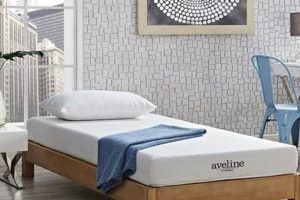
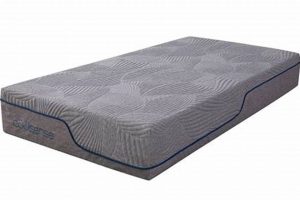
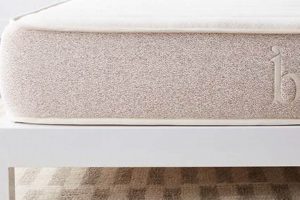
![Best Walmart Twin Size Blow Up Mattress [Guide] Organic & Natural Mattress Buyer’s Guide: Non-Toxic Sleep Solutions Best Walmart Twin Size Blow Up Mattress [Guide] | Organic & Natural Mattress Buyer’s Guide: Non-Toxic Sleep Solutions](https://mattressworldpa.com/wp-content/uploads/2025/07/th-5075-300x200.jpg)
